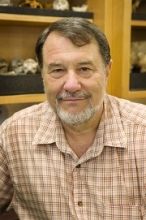Russell Ciochon, University of Iowa – Early Humans In Island Southeast Asia
 Have humans experienced rising sea levels in the past?
Have humans experienced rising sea levels in the past?
Russell Ciochon, professor of anthropology at the University of Iowa, explores this question and explains the history of some of our earliest ancestors.
Russell L. Ciochon is a professor of Anthropology at the University of Iowa in Iowa City, IA. As a paleoanthropologist, he studies Homo erectus from a variety of perspectives and has greatly extended our knowledge of this human cousin with regards to habitat preferences and their migratory routes into Asia roughly 1.6 million-years ago. He has worked at numerous sites across Asia including the Peking Man site of Zhoukoudian, China, and the Java Man site of Sangiran, Indonesia. Additionally, Ciochon has also conducted field work in various locales including Burma/Myanmar, Cambodia, Laos, Vietnam, the Siwaliks of India, China, and the Philippines. He also maintains an interest in the early evolution of our order, including the Eocene primates of Myanmar, the Miocene apes of India and China, and Gigantopithecus, the giant ape of Pleistocene Asia. His research has been funded by grants from the National Science Foundation, the L.S.B. Leakey Foundation, the Wenner-Gren Foundation for Anthropological Research, and the National Geographic Society. He has published 19 books and well over 100 articles and book chapters. Ciochon received his PhD in 1986 from the University of California at Berkeley under the pre-eminent paleoanthropologist, F. Clark Howell.
In 1992, Dr. Ciochon starting working with Dr. Roy Larick on a research project in China. Dr. Roy Larick is a Paleolithic archaeologist and owner of Bluestone Heights, an environmental education and consulting firm in Cleveland, OH. Ciochon and Larick started their joint Indonesian fieldwork in 1998. Their recent article, “Early hominin biogeography in Island Southeast Asia,” attached here, is the first to calibrate known early hominin sites with changing global sea-levels, ecological catastrophes, and other environmental factors across three climate periods of the Pleistocene, the epoch that ended with the last Ice Age. The article concludes that “Early hominins apparently responded to changing island conditions for a million-and-a-half years, likely becoming extinct during the period in which Homo sapiens colonized the region.” Ciochon and Larick, along with an international research team, continue their work on early hominin biogeography with an expedition to the islands of Timor and Sumba, Indonesia, in August 2015. Their goal is to examine the timing of Southern Wallacea outer arc early hominin occupation in relation to global and regional climatic events. This research is funded by a University of Iowa CGRER Seed Grant and the Ann and Gordon Getty Foundation.
Early Humans In Island Southeast Asia

It is easy to imagine early humans living on the high, dry rift valleys of East Africa, or on the cool steppes of western Eurasia. It’s more difficult to picture early humans living on the low, humid islands of Southeast Asia. Yet, for 1.5 million years, Homo erectus and its descendants survived on the volcanic archipelagos of Indonesia and the Philippines. Our research explores how early humans thrived in the ecologically-volatile region of Island Southeast Asia.
The first step is to understand the effects of shifting sea levels on island size and inter-connections. Global sea levels fell and rose as Ice Age glaciers advanced and retreated. During long cold periods, sea levels fell as much as 400 feet. Humans, and other animals, dispersed among generally larger landmasses and smaller sea passages. During the shorter warm periods, similar to today’s climate, large landmasses were reduced to smaller islands isolating inhabitants. In 1880, Alfred Russell Wallace demonstrated that diminished island resources produced unique evolutionary outcomes. For example, large animal species often get smaller, and small animal species sometimes become larger – today we call this “the island rule.” Few paleoanthropologists thought about island effects until 2004, when the surprisingly small early human species, Homo floresiensis, (the Hobbit) came to light on Flores Island. The Hobbit skeleton shows clear signs of insular dwarfing.
While early human fossils in Island Southeast Asia are rare, stone tools are abundant and indicate early human presence. Stegodon (the extinct Asian elephant) and early humans may have responded similarly to island habitats including insular dwarfing. On several islands, we are studying how stegodon fossils and stone tools are found together. We documented this association on a recent expedition to Timor in August. My colleague, archaeologist Roy Larick, and I are dating these associations and connecting them with global and regional climate events. Our goal is to comprehend how Island Southeast Asia became a unique early human stronghold.
Read More:
Larick-Ciochon-2015-Hominin Biogeography-ISEA-Evolutionary-Anthropology


